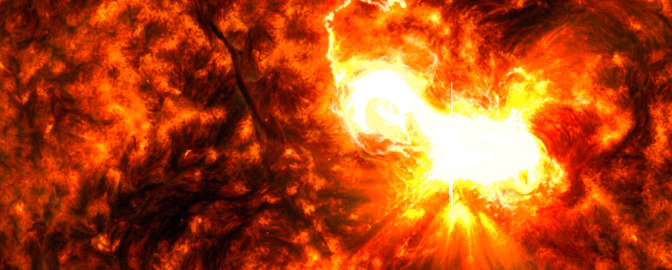The Downlink • Jul 18, 2025
Spaceflight worth the fight
Space Snapshot

This week marked the 10th anniversary of humanity’s first close-up encounter with Pluto, when NASA’s New Horizons spacecraft flew past the dwarf planet on July 14, 2015. This image is the most accurate natural color representation of what Pluto would look like to our eyes if we could see it in person.
Today, New Horizons is almost twice as far away as Pluto, exploring the outer reaches of the Solar System and making new discoveries every year. The mission is in danger, though. Learn more about the current state of the NASA budget and what you can do to help ensure missions like New Horizons keep delivering discoveries, images, and exploration firsts. Image credit: NASA et al.
Fact Worth Sharing

When New Horizons flew by Pluto in 2015, it discovered that its prominent heart-shaped nitrogen-ice plain has no impact craters, meaning that internal processes are reshaping the surface. Despite being so tiny and so far from the Sun, Pluto appears to be surprisingly geologically active.
Space Advocate Update

House rejects extinction-level cuts to NASA science
The House's Commerce, Justice, and Science subcommittee on appropriations just moved forward with a 2026 funding bill that rejects the massive cuts to NASA and NASA science proposed by the White House. It would provide $24.9 billion for the agency, equivalent to what it received in 2024.
Unfortunately, the House legislation would still cut NASA science by 18% (providing $6 billion in 2026), redirecting funding to the human exploration program. While 18% is far better than the 47% cut initially proposed, we believe that the House should adopt the Senate's position of full funding for science. Take action now to call on Congress to support NASA science.
You can also read The Planetary Society’s full statement on the funding bill, and watch a recording of a virtual webinar with Planetary Society policy leadership about what this budget would mean for NASA.
Mission Briefings


NASA’s Nancy Grace Roman Space Telescope is about 90% complete. In June, the observatory’s six enormous solar panel arrays were installed, bringing the spacecraft closer to completion. These panels will both power the telescope and shield its instruments from the Sun. Next steps include joining the inner and outer sections, vibration testing, thermal‑vacuum testing, and preparing for a potential fall 2026 launch. Pictured: Technicians installing solar panels. Image credit: NASA/Sydney Rohde.

ESA is considering new Mars and Venus missions. The proposed M‑MATISSE mission would send two spacecraft to orbit Mars and provide global mapping of Martian space weather, crucial for forecasting hazards to spacecraft and future crewed missions. The much lower-cost VERVE mission would send a cubesat to Venus to sample its clouds in search of trace biosignature gases like phosphine and ammonia. The European Space Agency will decide in mid-2026 whether to pursue the missions.

Astronomers witnessed a new planetary system forming for the first time. Using the ALMA telescope and the James Webb Space Telescope, researchers recently observed an exoplanet system in the earliest stages of planetary formation. This is the youngest planetary system ever observed, and gives researchers the chance to peer into our own Solar System’s past.
From The Planetary Society


What’s it like to experience micro-gravity? Former Planetary Radio host Mat Kaplan recently found out, joining Space for Humanity and Zero-G for a flight as part of a program that brings weightlessness and wonder to a diverse group of space dreamers. On this week’s episode of our weekly podcast, you can hear all about the experience, with recordings taken during the flight and reflections on what it means to open space to everyone. Image credit: Space for Humanity.

The latest from the Planetary Society book club: “The Overview Effect.” Author and space philosopher Frank White coined the term “the Overview Effect” to describe how seeing Earth from orbit changes a person. Today, many astronauts returning from space have embraced the term. Nearly forty years since the first edition of his book by the same name, Frank joined The Planetary Society’s book club to discuss the concept and how it has evolved over the years. You can watch the recording of the event here.

You can be Earth's first line of defense. Dangerous asteroid impacts are rare, but they do happen. And they will continue to happen unless we can prevent them. That’s where you come in! You can help advance the search for these near-Earth objects with a gift of any amount. Plus, when you give today, a generous Society member will match your gift dollar for dollar, up to a total of $25,000.
What's Up

This week, look for super bright Venus in the predawn east, joined by the crescent Moon on July 21. Jupiter shines very bright low to the evening eastern horizon, rising higher over the course of the night. Soon after sunset, Mercury is low in the west, with reddish Mars shining higher up. Yellowish Saturn rises in the middle of the night, staying in the sky until dawn. Find out what else to look for in July’s night skies.
Help save space missions. Join today!

If you are not already a member, we need your help. NASA is at a crossroads, and your support is needed today! Funding for space science and exploration is at risk. It needs the support of passionate advocates like you.
NASA is facing major budget cuts for the first time in a decade, and thousands of skilled scientists, engineers, and technicians have already been laid off at NASA centers across the United States. NASA funding must grow, not shrink, if the agency is to succeed in returning to the Moon, exploring the Solar System, and seeking out life beyond Earth.
We must prevent budget cuts. When you become a member of The Planetary Society, you join the world’s largest and most influential space advocacy nonprofit. Will you join us and enable the future of space exploration?
Sign up for the Nichelle Nichols Space Camp

The Nichelle Nichols Foundation is on a mission to send young women to space camp! The Planetary Society is partnering with the Nichelle Nichols Space Camp, where the spirit of Star Trek’s Starfleet Academy comes to life. Participants will work as a team to confront mission scenarios that require dynamic problem solving and critical thinking, mirroring the intensive training of NASA astronauts. Catering to a wide array of space enthusiasts, the camp offers programs in space, aviation, and robotics for girls ages 14 to 18, nurturing the next generation of explorers. Learn more and sign up today.
Wow of the Week

For the person who has everything, the next big purchase could be a piece of Mars. The largest Martian meteorite ever found on Earth was auctioned at Sotheby’s in New York this week. The 25-kilogram (54-pound) rock known as NWA 16788 is believed to have been blown off the surface of Mars by an enormous asteroid strike, sending it on a trajectory toward Earth. It was discovered in the Kefkaf region of Niger in 2023. Image credit: Richard Drew/AP.
Send us your artwork!
We love to feature space artwork in the Downlink. If you create any kind of space-related art, we invite you to send it to us by replying to any Downlink email or writing to [email protected]. Please let us know in your email if you’re a Planetary Society member!


 Explore Worlds
Explore Worlds Find Life
Find Life Defend Earth
Defend Earth

